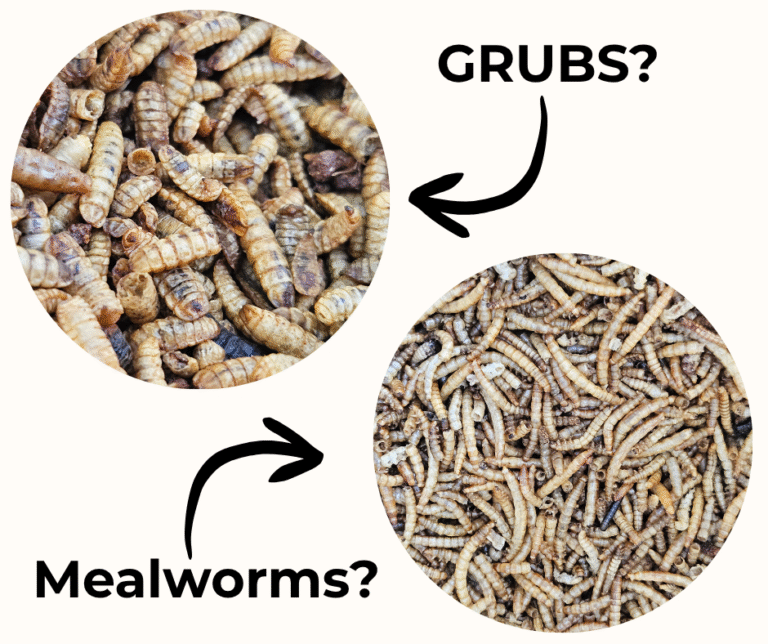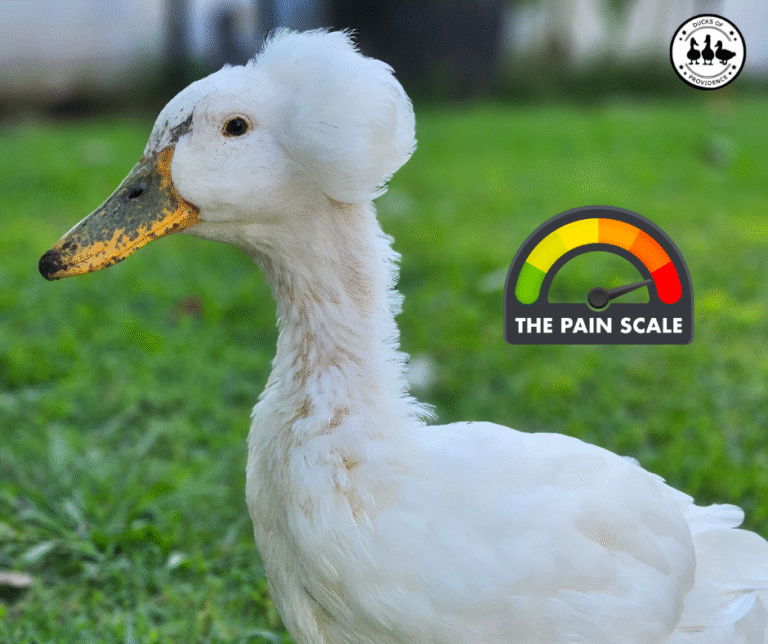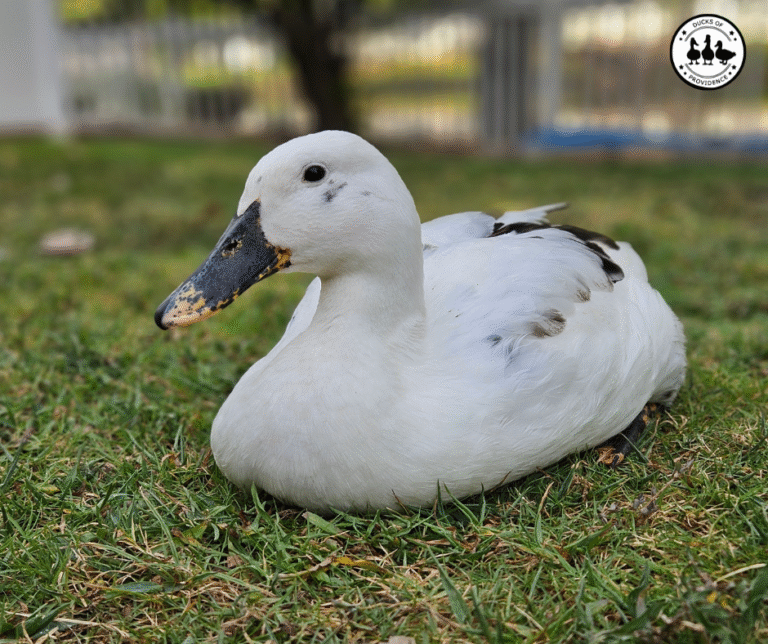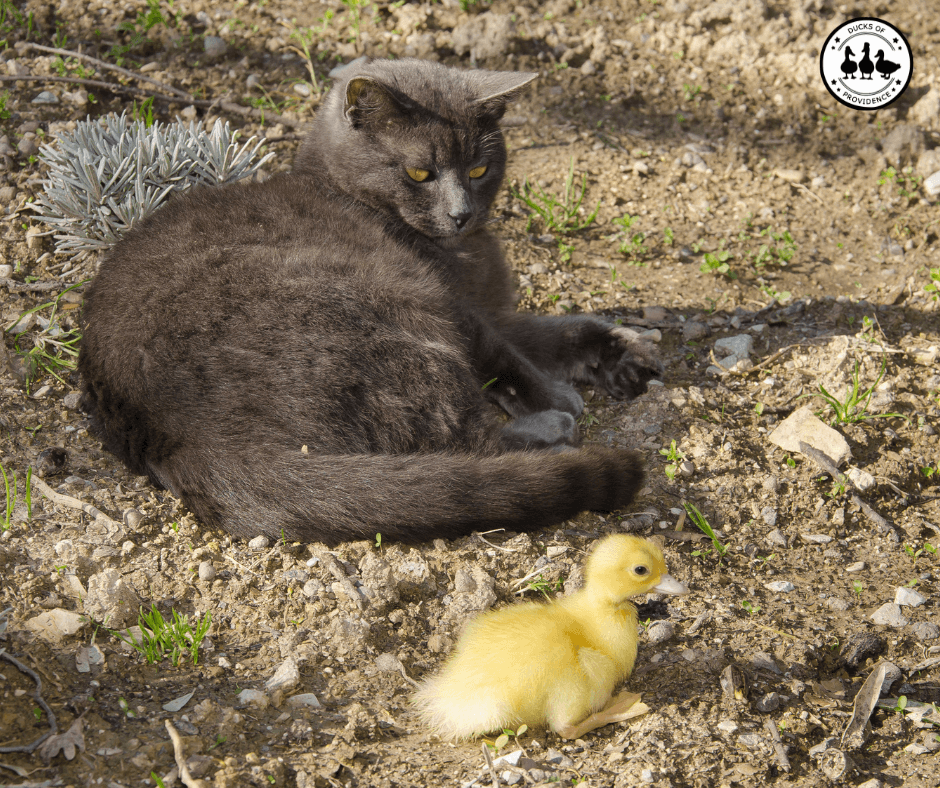
Ducks and Other Pets: Can They Live Together?
If you’ve ever wondered whether pet ducks and other pets can peacefully coexist with each other, you’re not alone. Many pet parents—especially those with backyard flocks—also have dogs, cats, or even rabbits in the home or neighborhood. While we personally don’t have other pets in our household, our ducks are definitely aware of—and curious about—the world beyond their run. They’ve watched the neighbor’s dog through the fence, followed the movement of roaming cats in our yard, and even had a bunny visitor hop by regularly. It’s been a great reminder that interactions between ducks and other animals can happen whether you plan them or not.
In this post, we’ll explore the most common household pets and how well they do (or don’t) mix with ducks. We’ll also share practical tips to help ensure safety and peace in a multi-species home.
Ducks of Providence is free, thanks to reader support! Ads and affiliate links help us cover costs—if you shop through our links, we may earn a small commission at no extra cost to you. Thanks for helping keep our content free and our ducks happy! 🦆 Learn more
Ducks and Dogs
Dogs and ducks can live together peacefully, but it requires caution, supervision, and a clear understanding of animal behavior. While some dog breeds are naturally more tolerant or protective, others have strong prey drives that make them unsafe around waterfowl. The success of this pairing depends largely on the dog’s personality, training, and how the introduction is handled.
What to know:
- Supervision is critical, especially during the first introductions.
- Use a fence or leash as a barrier when letting them see each other.
- Watch for body language—a fixated stare, stiff posture, or lunging are red flags.
- Never leave your dog and ducks unsupervised until you’re absolutely sure it’s safe.
- Some duck keepers report successful long-term coexistence with gentle, well-trained dogs—but it takes time and consistency.

Breed Instincts and Temperament
Dog breeds differ significantly in how they react to ducks:
- Herding breeds like Australian Shepherds or Border Collies may be tempted to chase and “round up” ducks. While this isn’t necessarily aggressive behavior, it can cause extreme stress or injury to ducks, especially ducklings.
- Hunting breeds and retrievers (such as Labradors, Spaniels, and Terriers) were often bred to pursue birds and may see ducks as prey, no matter how gentle they seem at home.
- Companion breeds and some mixed breeds may be more laid-back and tolerant, but it always comes down to the individual dog.
- Livestock guardian dogs (LGDs)—like Great Pyrenees, Anatolian Shepherds, or Maremmas—can be trained to protect flocks. These breeds have been used for centuries to guard sheep, goats, and poultry, including free-roaming ducks, from predators. However, they must be socialized early with the animals they are meant to protect.
Peaceful Coexistence Is Possible
Many duck owners successfully keep dogs and ducks together. Some key factors that increase the likelihood of peaceful coexistence:
- Introducing ducklings to an existing dog: When done with supervision and proper boundaries, adult dogs often learn to accept the ducklings as part of their “pack.”
- Raising a puppy alongside ducks: Puppies raised around ducks from the start often grow up seeing them as family, not prey.
- Training and socialization: Regardless of age, consistent training, impulse control, and desensitization can make a big difference.
Safe Introductions
If you’re introducing a dog to ducks, start slow and controlled:
- Begin with visual introductions through a secure barrier—like a fence or crate—so your dog can observe without direct contact.
- Watch your dog’s body language closely. Staring, stalking, whining, and tense posture can indicate a strong prey drive.
- Use a leash and positive reinforcement (treats, calm praise) to reward relaxed, non-reactive behavior.
- Progress slowly, and never force interaction. Not all dogs can be trusted around birds.
Warning Signs to Watch For
Even well-behaved dogs can become unpredictable. Be alert for:
- Fixated staring or trembling
- Whining, lunging, or pacing near the ducks
- Tail raised and stiff, hackles up
- Overexcitement or sudden barking
These behaviors indicate that your dog may not be ready for close interaction and needs more training or management.
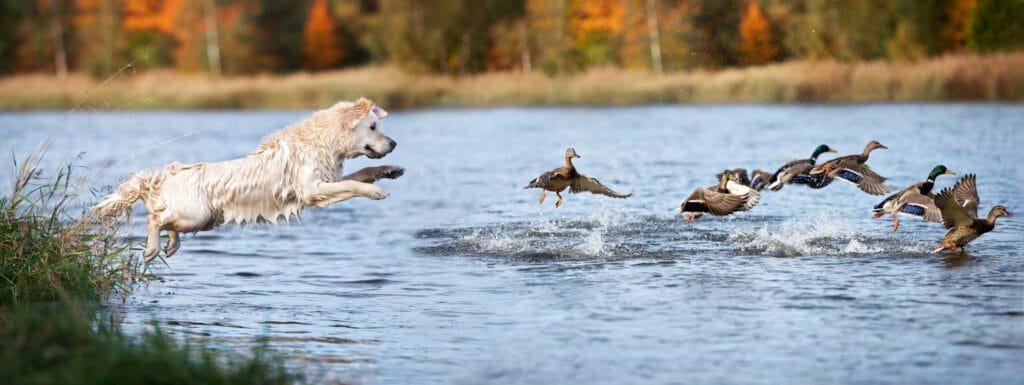
Supervision and Boundaries
- Never leave dogs and ducks alone together, even if they’ve been calm around each other for months.
- Use fencing, netting, or a crate when you aren’t present.
- Make sure your ducks have safe areas to retreat and that your dog can’t dig or jump into their space.
The Serious Risk of Dog Bites
Dog bites—whether from a playful nip or a more aggressive attack—should always be taken seriously. While dogs don’t carry the same specific bacteria as cats, their strong jaws and blunt teeth can cause severe internal damage, even if the skin isn’t broken or the wound looks minor.
- A duck’s body is not built to withstand the force of a dog’s bite. Even a “gentle” dog can unintentionally cause crushing injuries, broken bones, or internal bleeding with just one bite.
- Infections are still a concern. While dog saliva doesn’t typically carry Pasteurella like cats, it can still introduce bacteria like Staphylococcus, Streptococcus, or E. coli, especially if the skin is broken.
- Ducks often hide signs of pain or injury, so internal trauma can go unnoticed until it becomes critical.
What to do if your duck is bitten by a dog:
- Thoroughly clean the wound with a diluted antiseptic solution.
- Check for signs of swelling, bruising, or limping—even if the skin looks intact.
- Consult a veterinarian immediately. X-rays may be needed to check for fractures or internal damage, and your duck will likely need antibiotics and pain management.
As heartbreaking as it is, many duck fatalities from dog attacks happen in just a few seconds—and often with dogs the owners thought were safe. This is why even well-trained dogs should never be left alone with ducks, especially smaller or younger members of the flock.
Ducks and Cats
Cats are natural predators, especially when it comes to birds and small animals. However, adult ducks are typically too large to be seriously threatened by a housecat. Ducklings, on the other hand, are extremely vulnerable and should never be left alone with a cat, no matter how docile or lazy the cat may seem.
Tips for managing cats and ducks:
- Always keep ducklings secured—a cat-proof brooder is essential.
- Give cats their own vertical space and safe retreat zones if housed together.
- Watch for stalking or pouncing behavior, even in play—it’s still risky for ducks.
- Some cats lose interest quickly in ducks once the novelty wears off.
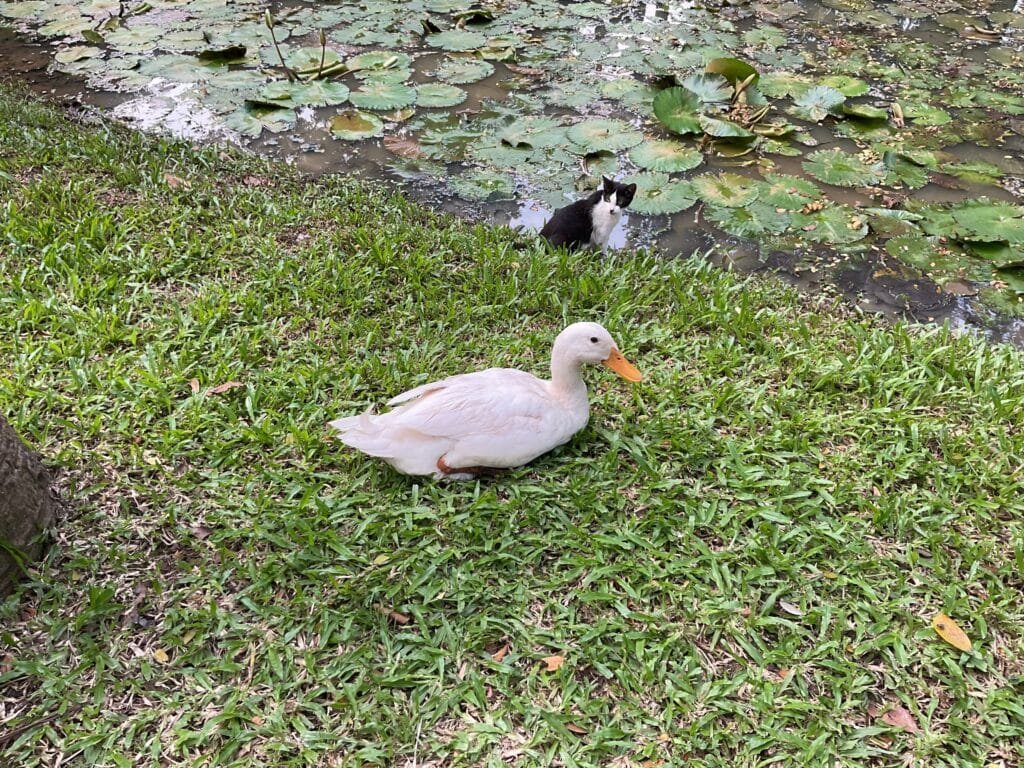
Predatory Instincts
Even the calmest indoor cat may still retain a strong prey drive. The quick movements and small size of ducklings can trigger instinctual pouncing or swatting. While these behaviors may appear playful, they can result in serious injury or death.
That said, some cats quickly lose interest in ducks—especially once the novelty wears off and the ducks grow larger. It’s not uncommon for cat and duck owners to report peaceful coexistence, especially in homes where boundaries are respected and the animals aren’t forced into direct interaction.
Tips for a Safe Setup
- Keep ducklings securely enclosed. A brooder with a lockable lid or wire mesh top is essential if there’s a cat in the home.
- Create vertical spaces for cats. Give your cat high shelves or perches where they can observe the ducks from a safe distance without feeling the need to interact.
- Supervise early encounters. When the ducks are fully feathered and large enough, you can allow carefully supervised visits in a controlled space.
- Watch both animals’ body language. Ducks may become nervous or agitated in the presence of a cat. Cats may crouch, stare, or flick their tails—a sign they’re preparing to pounce.
Coexistence Is Possible
Many people successfully keep cats and ducks under the same roof, especially when:
- The ducks are adults and confident.
- The cat has a low prey drive or has been raised in a multi-species household.
- The home is set up to give both species space and independence.
Still, it’s important to remember that even a single moment of predatory behavior can lead to an injury. Supervision is always a smart precaution, especially with ducklings.
Outdoor Considerations
If you allow your ducks to free-range and there are outdoor cats in your neighborhood—as is the case in our own yard—always assume that ducklings are at risk. Cats that would never dream of hunting indoors may behave very differently outdoors.
Even with adult ducks, some cats may stalk or chase them. While most adult ducks can outrun or outflap a curious cat, the stress alone can lead to panic, injury, or difficulty returning to the coop.
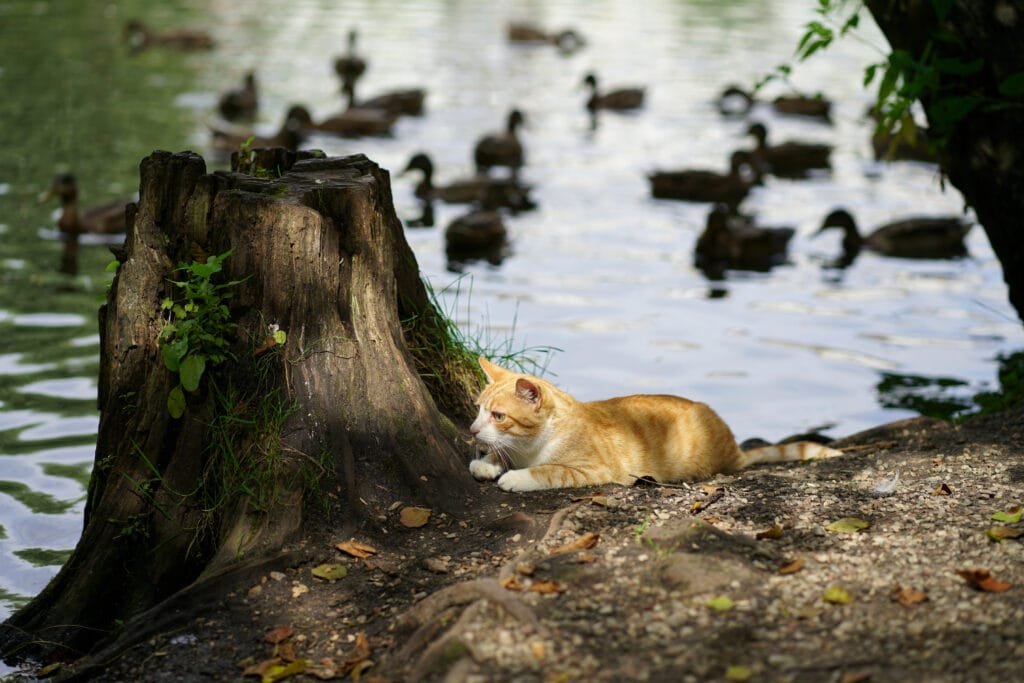
The Hidden Danger: Cat Bites
If a cat ever bites a duck—even just once—it’s a true emergency, no matter how minor the wound may appear.
- Cats’ mouths harbor Pasteurella multocida, a type of bacteria that can cause life-threatening infections in birds. These infections can spread rapidly through the body and become fatal within 24 to 48 hours if not treated.
- Puncture wounds can close over quickly, trapping bacteria deep in the tissue. You may not see visible swelling or bleeding right away, but the duck can still be in serious danger.
What to do if a cat bites your duck:
- Clean the wound immediately with a diluted antiseptic solution (like povidone-iodine or chlorhexidine).
- Contact a veterinarian right away. Ducks will likely need antibiotics, ideally within the first 12 hours.
- Watch for signs of systemic infection: lethargy, swelling, loss of appetite, or labored breathing.
Even if the duck seems fine, it’s always better to be safe. The earlier an infection is treated, the better the outcome.
➡️ Learn more about first aid wound care
Ducks and Chickens
Ducks and chickens are both common backyard birds, so it’s no surprise that many people keep them together. While they can often coexist peacefully—especially during the day—it’s important to understand their very different behaviors, health needs, and social dynamics to avoid problems.
Key considerations:
- Feeding: Chickens and ducks require different feed formulations, especially when young.
- Health: Ducks are more water-tolerant, while chickens need dry conditions—wet bedding can lead to respiratory issues.
- Bullying: Chickens may peck at ducks, especially drakes or young ducklings.
- Best practice: House separately at night and ensure plenty of space if they share a run.
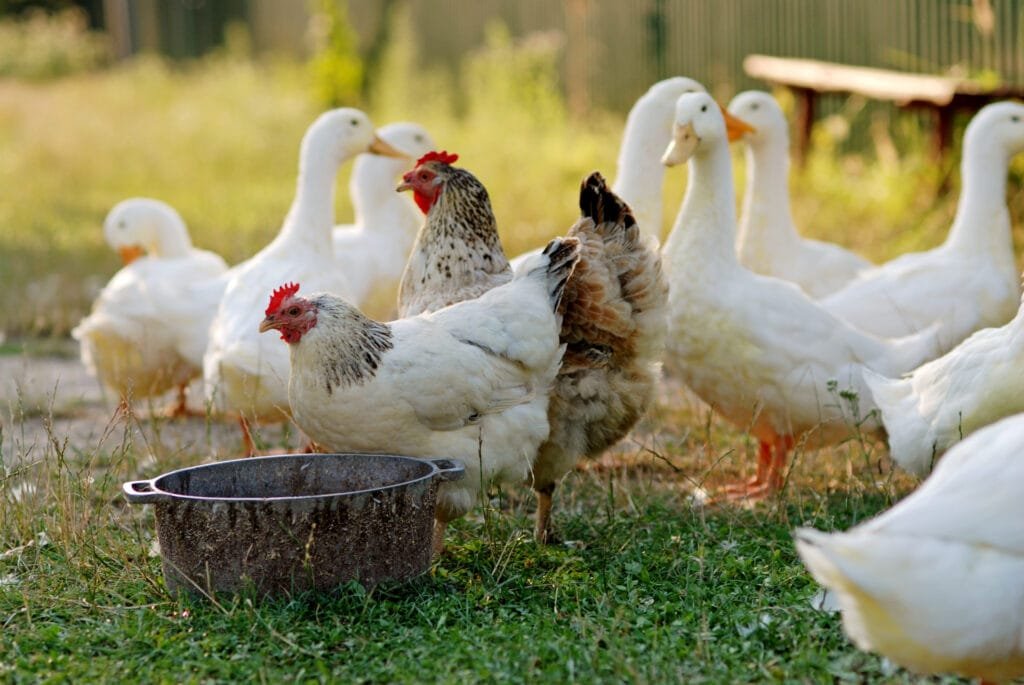
Different Needs, Different Behaviors
At first glance, ducks and chickens might seem like a perfect match. They eat similar feeds (at least in adulthood), enjoy outdoor space, and thrive in a flock environment. However, the way they live and interact with their environment differs significantly.
- Sleeping habits: Chickens prefer to roost off the ground at night, while ducks sleep on the floor. Mixing the two in one coop can lead to ducks being trampled by roosting chickens or creating too much mess underneath the roosts.
- Hygiene: Ducks are much messier than chickens. They splash water, soak bedding, and can quickly create a damp environment that chickens are not well-suited to. Wet bedding can lead to respiratory illness or foot infections in chickens.
Feeding and Water Needs: Different Systems, Different Habits
While ducks and chickens may appear to have similar diets, their nutritional and hydration needs are quite different—and these differences can cause real issues if not managed properly.
Nutritional Needs
- Niacin (Vitamin B3): Ducks need more niacin than chickens—not just as ducklings, but throughout their lives. A deficiency can lead to leg deformities, poor growth, and neurological symptoms.
- Macronutrients: Ducks require slightly more protein, different amino acid ratios, and sometimes higher energy intake, especially during periods of egg laying or molting.
- Feeding behavior: Ducks tend to mix their feed with water to create a slurry, which chickens find unappetizing. Chickens, on the other hand, peck at dry feed and don’t tolerate wet or soiled food well.
Water Access
- Chickens often drink from nipple-style waterers or small cups that help keep their coop dry. These systems are clean and efficient for dry-loving birds.
- Ducks require deep, open water sources where they can fully submerge their bills to keep their nostrils clear and clean out their eyes. Without access to deep enough water, ducks can develop eye infections and respiratory problems.
- Ducks are naturally messy and will quickly turn a shared water source into a muddy, splashy mess—a major hygiene concern for chickens.
Best practice:
- Use separate waterers suited to each species.
- Place duck waterers outside the chicken coop if the space is shared.
- Maintain good drainage around duck water bowls to minimize mud and moisture buildup.

Nighttime Separation Is Essential
Even if they range together during the day, ducks and chickens should be housed separately at night. Here’s why:
- Ducks stay active longer into the evening and often settle in messier areas.
- Chickens go to roost at dusk and can become stressed or pecked if disturbed by moving ducks.
- Most importantly, separating them reduces the risk of cross-species aggression and ensures each flock gets the housing conditions they need.
We recommend separate coops or a shared structure with distinct zones: elevated roosts for chickens and floor-level bedding areas for ducks, with dedicated entrances and dividers.
Drakes and Chicken Hens: A Dangerous Combination
One of the biggest risks in mixed flocks arises when you have male ducks (drakes) housed with chicken hens. Drakes have different anatomy than roosters and can cause severe injury—even death—if they attempt to mate a chicken. This is not just a behavioral issue but a serious physical danger due to the structural incompatibility between the species.
If you have drakes, never allow unsupervised access to chicken hens, and ideally avoid mixing species altogether during breeding season. Even without mating attempts, drakes can be rough and dominant, causing stress or injury to smaller birds.
When It Can Work
Many backyard flock keepers successfully keep ducks and chickens together—especially if:
- The birds are raised together from a young age.
- You provide plenty of space in the shared run, with visual barriers and enrichment.
- You manage feeding and water areas separately, so ducks don’t foul the chickens’ feed or waterers.
- You’re diligent about cleaning and monitoring health on both sides of the flock.
Ducks and Rabbits
Ducks and rabbits are both popular backyard pets—but that doesn’t mean they make good roommates. While they can sometimes share outdoor space under strict supervision, their environmental needs, social behaviors, and hygiene requirements are very different. In most cases, it’s best to house them separately and allow only occasional, monitored interaction.
Why it’s tricky:
- Ducks are messy and wet, while rabbits require dry, clean living areas.
- A curious duck may peck or even mount a rabbit.
- Rabbits can get easily stressed by fast movements or loud quacking.

Hygiene and Habitat: A Fundamental Mismatch
- Rabbits require a dry, clean, and relatively dust-free environment. Moisture, soiled bedding, and mud can lead to respiratory issues, sore hocks, or serious infections like flystrike.
- Ducks are messy by nature. They splash water everywhere, wet their bedding, and often trample through food and waste. A space suitable for ducks is typically unsuitable for rabbits.
- Even outdoors, muddy or damp ground can cause health problems for rabbits over time.
Risk of Injury
- Ducks are larger, heavier, and clumsier than rabbits. A curious duck may unintentionally step on, peck at, or chase a rabbit—especially in tight spaces.
- Male ducks (drakes), in particular, can be aggressive during breeding season. In rare but serious cases, drakes have attempted to mount rabbits, leading to traumatic injuries.
- Rabbits are easily stressed by sudden movement or noise, and the presence of active ducks can elevate their anxiety levels.
When It Might Work
Peaceful coexistence is most likely when:
- The rabbits and ducks are only outdoors together in a spacious area, such as a large pen or yard.
- You provide species-specific shelters, feeding stations, and rest areas.
- The animals are monitored during interactions, especially early on.
- There are no drakes present, or they’re kept physically separate from the rabbits.
- You avoid housing them together overnight or during inclement weather.
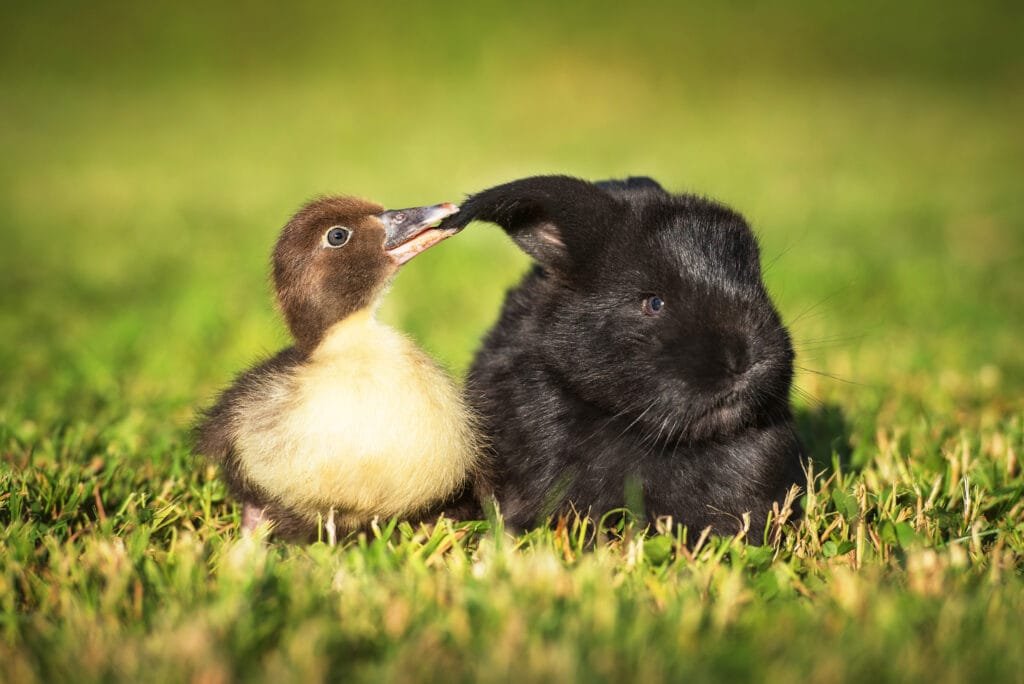
That said, most experienced keepers agree: long-term co-housing is not recommended. The health and safety needs of rabbits are just too different from those of ducks.
Ducks and Other Pet Birds (Parrots, Parakeets, Cockatiels)
Pet ducks and pet birds can coexist under the same roof, but only if they are kept in separate cages and their environments are carefully managed. While it’s tempting to imagine a feathered friendship, ducks and smaller pet birds like parrots or budgies have very different care needs—and physical interaction between the two species is not recommended.
Important tips:
- Do not allow shared cages or perches.
- Keep feeding tools and water sources separate.
- Avoid introducing airborne dander from dry, dusty birds near ducks.
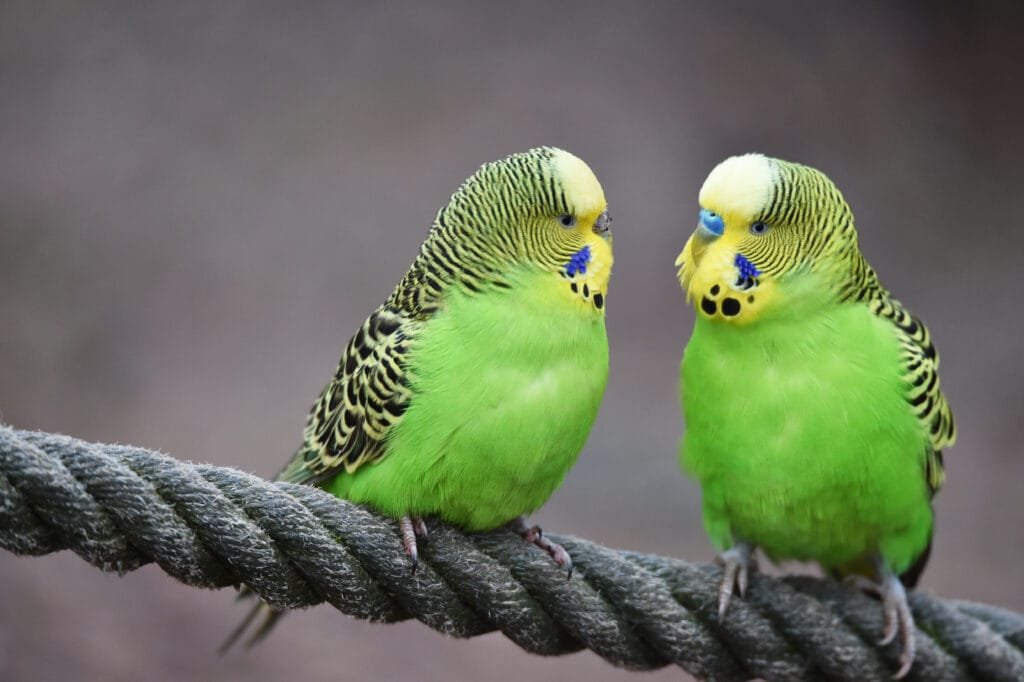
Key Differences in Environment and Health Needs
- Ducks are wet, messy birds. They splash water, create humidity, and need regular access to bathing areas.
- Pet birds such as parrots, cockatiels, lovebirds, and parakeets need a dry, clean, and low-humidity space, as high moisture can contribute to respiratory infections and mold growth in their enclosures.
- Dust and dander from pet birds can also negatively impact ducks, especially if both species share the same airspace over extended periods.
What Coexistence Can Look Like
Many pet owners—especially those who keep ducks primarily outdoors—also have indoor bird companions in cages. As long as each species has its own space, own equipment, and limited overlap, this can work well.
- If your ducks occasionally visit indoors (for nighttime snuggles, medical recovery, or supervised time out of the weather), it’s generally safe as long as the pet birds remain secured in their cages and the room is well-ventilated.
- Avoid placing bird cages near duck bedding areas or water dishes. Moisture from ducks can raise humidity and introduce bacteria into nearby environments.
- Make sure ducks cannot reach or peck into bird cages, as a curious duck bill can be surprisingly forceful.
What to Avoid
- Never allow ducks and pet birds to free-roam together, even under supervision. A duck may try to nibble or peck a smaller bird, and birds with clipped wings or poor flight can’t always escape.
- Don’t share feeding or water equipment. Ducks need deep bowls to clean their nostrils, while pet birds drink from small, clean dishes or water bottles.
- Avoid placing both species in confined or poorly ventilated rooms, especially overnight.
Bottom Line
Ducks and pet birds can share a household peacefully as long as they are properly separated and their needs are met individually. With appropriate cage placement, air circulation, and species-specific care, occasional indoor overlap is fine—especially if ducks are only inside now and then.
Ducks and Small Mammals (Hamsters, Guinea Pigs, etc.)
Small mammals are sensitive, fast-moving, and highly responsive to changes in their environment. While it’s not uncommon for duck keepers to also have pets like guinea pigs, hamsters, or ferrets in the home, it’s important to recognize that ducks and small mammals are fundamentally incompatible when it comes to shared living space.
Why It’s a Risky Combination
- Environmental needs are completely opposite. Ducks thrive in wet, messy conditions. They splash, spill, and soak their bedding and water areas—whereas small mammals need a dry, clean, and low-moisture environment to prevent respiratory disease and skin infections.
- Ducks are much larger and less aware of their bodies than smaller animals. Even a gentle duck can accidentally injure or trample a guinea pig or hamster during a curious inspection or an unintentional step.
- Stress is a serious concern. Small mammals—especially prey animals like rabbits, guinea pigs, and hamsters—are easily stressed by loud noises, fast movement, and unfamiliar scents. Chronic stress can suppress their immune systems and even lead to organ failure over time.
- Ferrets, while technically predators themselves, are not a safe pairing either. They are quick, curious, and carnivorous—and a ferret and a duckling should never be allowed in the same space.
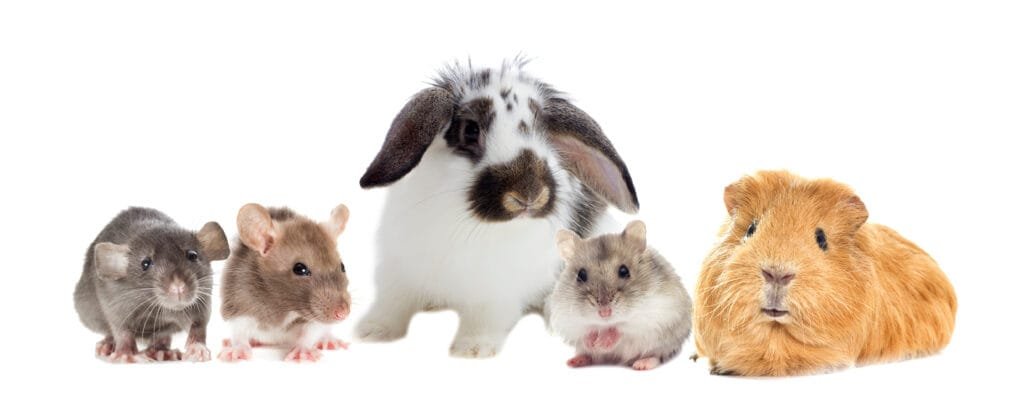
If They Must Share a Household
Some people keep small mammals in the same household as ducks—especially if the ducks are outdoors and the other pets live inside. This can be done safely with proper separation:
- Keep species-specific spaces. For example, if your ducks come indoors occasionally (due to illness, weather, or personal choice), make sure they’re in a different room from small mammals.
- Use secure cages with tight wire spacing to prevent ducks from sticking their bills into small pet enclosures.
- Avoid shared airspace in small rooms, especially in warm weather, when moisture and odors from duck bedding can spread easily.
- Always monitor for signs of stress in your small pets: hiding more than usual, loss of appetite, abnormal droppings, or changes in behavior.
Housing Arrangement Tips
- For guinea pigs, hamsters, rats, or mice, keep cages off the ground and away from duck activity.
- For house rabbits, use a separate pen with full physical separation from duck traffic, and ensure the flooring stays dry and insulated.
- Never allow physical contact between ducks and small mammals, even under supervision. The risk of accidental harm is too high.
Bottom Line
While it’s possible to keep ducks and small mammals in the same home, they should never interact directly, and their habitats must be completely separate. Ducks are too messy, strong, and unpredictable to safely share space with these fragile species. With thoughtful boundaries and an understanding of each species’ needs, you can protect both and give them the safe, comfortable environments they deserve.
Ducks and Aquatic Pets (Fish Tanks and Pond Fish)
Ducks and fish can live peacefully in the same household—or even the same backyard—but only under the right conditions. While ducks don’t typically interact directly with indoor aquariums, backyard ponds are a different story. Understanding how ducks behave around water and how they affect aquatic environments is key to keeping both species healthy and safe.
Things to consider:
- Ducks may eat small fish. They forage by dabbling and will naturally go after anything that wiggles and fits in their bill.
- Larger fish are usually safe, but fingerlings or fry may disappear quickly.
- Ducks can muddy the water and disturb pond plants or filtration systems.
- If you want to keep both ducks and fish, consider adding hiding spots, like rock caves or dense underwater plants, to give fish a chance to escape.
Indoor Aquariums
If you have an indoor aquarium with tropical fish, goldfish, or aquatic turtles, you generally won’t run into any issues, as long as the tank is kept secure and out of the ducks’ reach.
That said, ducks can still pose risks:
- Ducks are naturally curious and may peck at anything shiny or moving. If your aquarium is placed on the floor or near a duck-accessible area, they may try to investigate.
- Cords, heaters, filters, and tubing can be tempting for ducks to nibble or pull. Chewed cords pose electrical risks, and damaged filtration equipment can threaten your fish.
- Ducks are also messy. Even short indoor visits can introduce splashing, airborne moisture, and bedding dust, which can contaminate tank water if the lid is not well-sealed.

Tips for safe coexistence:
- Keep aquariums elevated or placed behind barriers.
- Use secure lids that prevent water contamination and prevent ducks from sticking their bills into the tank.
- Avoid housing aquariums in the same room where ducks spend extended time indoors—especially during brooding or recovery periods.
Backyard Ponds
Outdoor ponds are much more likely to bring ducks and fish into direct contact—and not all fish will survive the encounter.
Ducks Are Dabblers by Nature
Ducks love to forage by dabbling in shallow water. Their bills are highly sensitive and excellent at detecting movement, which makes small pond fish especially vulnerable, including:
- Koi fry
- Goldfish under 3 inches
- Mosquitofish and minnows
If a fish can fit into a duck’s bill, chances are it won’t be there long.
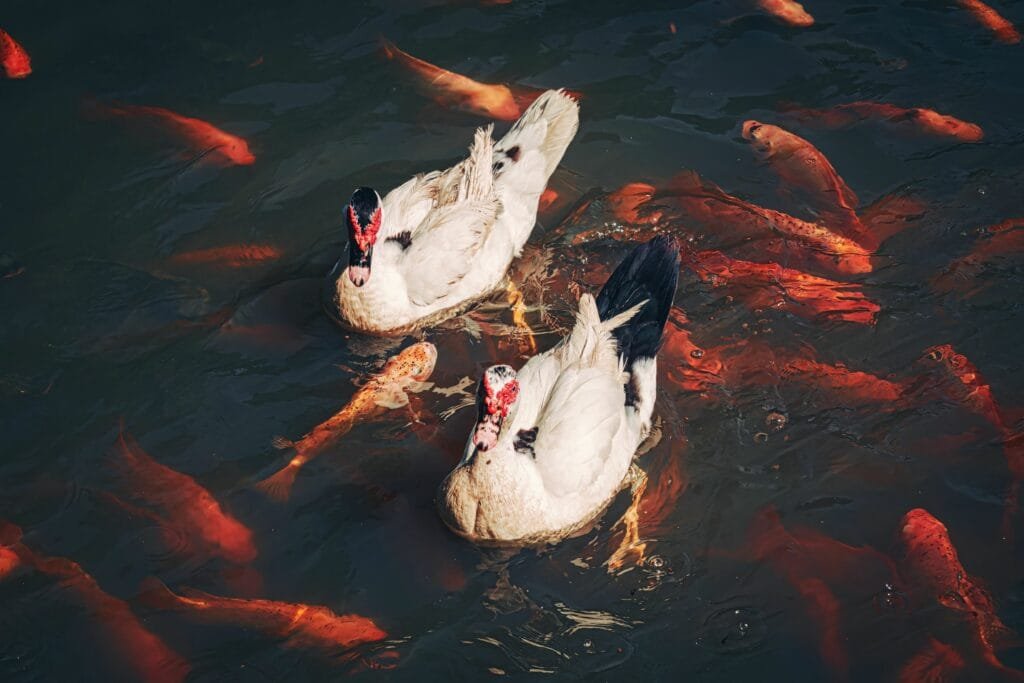
Water Quality Concerns
Even if you don’t keep fish, adding ducks to a pond changes the ecosystem:
- Ducks introduce droppings, feathers, and mud into the water, which increases nutrient loads and can lead to algae blooms, clogged filters, and ammonia spikes.
- Frequent dabbling disturbs sediment, making it harder for filtration systems to keep water clear.
- In small or delicate pond ecosystems, duck activity can upset the balance entirely.
How to Protect Pond Fish
If you want ducks and pond fish to coexist, design your pond with safety and sustainability in mind:
- Include deep zones where ducks can’t reach the bottom with their bills (at least 2–3 feet).
- Add hiding spots like submerged rock caves, large aquatic plants, or PVC tunnels to help fish escape.
- Consider fencing or limiting duck access—perhaps allowing pond visits only under supervision or on a rotation schedule.
- Use high-capacity filters designed to handle the extra bio-load from ducks.
Some duck keepers have found success with larger koi, which are less vulnerable to predation and often coexist well with adult ducks. But small or young fish will always be at risk unless protected.
Bottom line: Ducks and fish can share a space, but the more access ducks have, the more carefully you’ll need to manage your pond or tank. Consider the long-term impact on both species’ health and habitat, and plan accordingly.
Tips for Introducing Ducks to Other Pets
🗹 Always introduce slowly and with barriers – Visual introductions first, using fences or leashes to gauge reactions.
🗹 Supervise interactions at all times – Especially during the first few weeks or when introducing new animals.
🗹 Separate housing at night – Ducks should never share overnight spaces with chickens, rabbits, or small mammals.
🗹 Use species-appropriate waterers and feeders – Ducks need deep bowls to clear their nostrils; chickens use nipples or shallow dishes.
🗹 Watch for signs of stress or aggression – Ducks head-bobbing, panting, or freezing; dogs staring or pacing; cats crouching or flicking tails.
🗹 Provide escape zones – For fish in ponds, use rock caves or PVC pipes; for chickens, create visual breaks in the run.
🗹 Avoid shared equipment – No shared water, feed, or bedding between species to prevent disease spread.
🗹 Be mindful of drakes with hens – Male ducks can cause serious injury if they try to mate with chicken hens.
🗹 Secure aquariums and cords – Ducks are curious and may peck at fish tanks or chew electrical cords.
🗹 Check for injuries immediately – Cat or dog bites can be life-threatening; even small punctures need prompt vet attention.
Final Thoughts
Ducks are incredibly observant, curious, and social animals. Whether they live primarily outdoors or occasionally spend time inside, they will notice—and often investigate—other pets around them. Even though we don’t have other animals in our household, we’ve seen our ducks respond with interest to neighborhood cats, the neighbor’s dog through the fence, and even a little bunny that visits our yard. These interactions remind us that ducks don’t live in a bubble—they share their environment, and it’s our responsibility to make sure those interactions are safe.
As we’ve explored in this guide, ducks can coexist with a variety of other animals, including dogs, cats, chickens, rabbits, fish, and even certain indoor pets—but only with the right precautions. It’s never just about whether it’s “possible”; it’s about creating an environment that meets the specific needs of each species. That includes physical safety, emotional well-being, nutritional requirements, and hygiene.
Every animal is different, and every setup is unique. Whether you’re considering adding a dog to your flock, letting your ducks roam near a fish pond, or managing occasional indoor overlap with other pets, remember to observe, adjust, and put safety first.
Your ducks will thank you for it—with head tilts, gentle quacks, and all the curiosity in the world.
Have you kept ducks with other pets? We’d love to hear about your experience! Share your stories in the comments below, or tag us on Instagram @ducks_of_providence so we can see your feathered (and furry!) friends coexisting.
Related Articles
- Emergency Care for Ducks After a Predator Attack: First Aid, Treatment, and When to See a Vet
- How to Conduct a Duck Health Check: A Comprehensive Guide
- The Importance of Niacin for Ducks: What Every Duck Keeper Should Know
- Essential Nutritional Needs of Ducks: A Complete Overview
- Can You Keep Ducks Indoors as a House Pet?

